Traditional winter training in Japan: The Kashima jodo gasshuku
By Deborah Klens-Bigman, Ph.D.
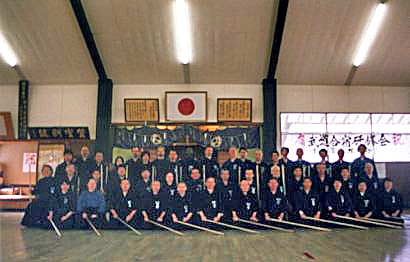 |
The February 2008 jodo gasshuku participants.
Photo courtesy of T. Kaminoda. |
I was surprised by the cold. I had been warned, of course, to bring extra clothing, to bring layers, tabi (traditional footwear) and, importantly, long underwear, but I had not been expecting its deep penetration, its constant thereness. Like an animal, after awhile all I wanted was to find something - a patch of sunshine on the floor, a hot can of tea - to warm me up.
For those unfamiliar with this martial art form, jodo (lit. "the way of the stick") is a method of non-lethal control of a sword-wielding assailant. Though its antecedents probably go back hundreds of years, jodo became a law enforcement method in the 18th century. To this day, the largest group of practitioners in Japan are policemen, who learn modern jodo tactics in addition to traditional training. In practice jodo involves kata that pits a pole 128cm long by 2.4cm in diameter against a wooden sword. Kaminoda Tsunemori is headmaster of a branch of Shindo Muso Ryu jodo, a very prominent teacher in the most-popular style.
After years of listening to Peter Boylan talk about Kaminoda Sensei's jodo gasshuku (which translates, roughly, as the now much-maligned expression "training camp"), held twice a year in Kashima, about an hour outside Tokyo, I was there. And it was all true - the spartan feel, the simple, hardy food, the long hours of all-consuming practice and the cold, cold, cold.
The 2008 winter gasshuku was held on February 9-12. Since the weekend included a holiday, the regular practice this year began on Saturday and did not end until Tuesday afternoon. We trained in mostly in Shinto Muso Ryu jodo, though also in related koryu budo - kenjutsu (sword partner kata), hojojutsu (rope tying) and for the advanced students, kusarigama (a ball and chain or length of rope attached to a hand-held sickle).
Though the gasshuku followed a set pattern laid down over the years (for a traditional outline, see Sosnowski 2005), this year's holiday schedule meant some variation on the theme.
A gasshuku is not a public training session. One attends by invitation only, and attending one is a privilege. Attendees are expected to keep up with the training, barring any illness or injury. No whining, no complaints; after all, everyone is a volunteer. The good part is that the cost is also low - profit not being the motive for holding an intensive session (a true mark, to me, of a traditional style, as opposed to a business-oriented one). Attendees are expected to be polite and helpful, cooperating with group chores and expressing deference to senior students and teachers.
As a first-time, unranked participant, I was on the very low end of this arrangement, so it was actually pretty simple to comply with all the rules and regs and deferential behavior, since I was oblivious to whatever political undertones such a large gathering can entail. And in fact, there was very little factionalism evident. Whatever people's differences might have been, they were not expressed here. Serious discussions evolved on differing opinions of technique or meaning. To a junior student to be able to overhear such discussions was like gold, but all talk would cease with the appearance of Kaminoda Sensei on the floor. At that point interpretation took a back seat to practice, regardless of rank.
I wondered beforehand whether I could handle the several days of training. I am not particularly young, and like a lot of people who have practiced martial arts for a long time, experience was being tempered with various, though minor, aches and pains. The word "gasshuku" implies intensity. Forget jet lag: my only concern was whether I could keep up with everyone else and not make a fool of myself in the process; or tear anything; or lose anything.
The shadow of my teacher, Otani Yoshiteru, hovered over the entire experience. Otani Sensei had known Kaminoda Sensei years ago, when they studied jodo together for a time. I first met Kaminoda Sensei when he came to the United States in 1996. Once he found out I was to meet him, Otani Sensei charged me specifically to introduce the members of our group to Kaminoda Sensei - "You tell him I said 'yoroshiku,'"(i.e., "give him my regards") he commanded. As usual, with my then-minimal Japanese, I was afraid to use it, but I was more afraid of facing Otani Sensei having not done as he asked. I carried out the task, though I doubted very much, all these years later, that Kaminoda Sensei would remember me. Since I had barely practiced jodo in the interim, I was actually hoping he did not.
All the same, though it was Peter's urging that got me to Kashima, I could feel Otani Sensei's presence; pushing, cajoling and spiritually kicking my butt. One never knows how meeting one person who is not a relative, or even, strictly speaking, a friend, can shape one's entire life. But there I was, in Kashima, in the presence of my teacher's old friend.
I arrived Friday night, and, as usual, was my post-Japan flight mess - I felt like I had been without a shower for two days, which was true. We eventually met up with Peter and commandeered a cab from the airport to the Shimbuden in Kashima, the dormitory/dojo compound where we would train for the gasshuku. The place was quiet and nearly empty - the official opening was not until tomorrow. In prior years, Peter, a veteran of multiple Kashima gasshuku, stayed at a hotel near the airport and went to Kashima the next morning, but this time splitting the cost of a cab was cheaper than a hotel room, and the cost of the extra night at the Shimbuden was minimal.
The place was not entirely deserted, however, as Kamindoda Sensei met us in the entryway. He looked just the same as I remembered, though he was now about 80 years old. After a little discussion, he decided on a conveyor-belt sushi restaurant and whisked us off to dinner. It took a little while, but we reminded him that we had met him 12 years before. I don't think he really remembered, but he was gracious about it nonetheless.
After we returned to the Shimbuden, we begged to have the hot water turned on so we could wash the foreign travel off of us. There was no opportunity to soak (the ofuro (bathtub) had not been set up yet), but after a shower, I felt almost human again. Then we sat up with Kaminoda Sensei and ate mikan (small oranges), talking about koryu budo into the night. I can never sleep on planes, so by 11pm I was almost insensible, but I would not have traded that quality time with Kaminoda Sensei for a night's sleep - we could always do that later.
The next morning, Kaminoda Sensei had business at Kashima Jingu, a large Shinto shrine in the center of town, so we were invited to tag along. It was a decent day, not that cold if you were wearing regular clothes. While Kaminoda Sensei met with the chief priest, we wandered around. As a martial arts-dedicated shrine (along with Katori Jingu, which was not far away), Kashima Jingu included a dojo building and a kyudojo - an archery range - on the grounds. Soon Kaminoda Sensei's business was concluded and we headed back to the Shimbuden for lunch and the official start of the gasshuku.
By now, the Shimbuden was transformed from an empty-feeling place, like only large buildings can be, to bustling activity as people arrived with bags of clothes and equipment. In addition, 40 boxes of botan, a thick-skinned citrus fruit, had arrived from Kyushu, along with several boxes of bananas. Kaminoda Sensei apparently believes in fruit for health; not so unusual where I come from, but fruit is a precious commodity in Japan. I had never seen so much of it in one place. And we would learn to love botan, at breakfast, lunch and dinner.
Facilities at the Shimbuden ranged from the very spartan (rooms full of bunk beds, each furnished with a single tatami (straw) mat in lieu of a mattress) to the not bad (tatami rooms that slept four or five). I was fortunate to be assigned to the latter (there were not many female participants) and over the course of the weekend I would end up with a total of three roommates. The rooms had individual heaters (and double doors to block out the seeping cold from the hallway), but by the time we had our full compliment, we hardly needed any help to keep warm at night.
That is, as long as we stayed inside the rooms. The cold was so pervasive (and such a contrast to the cozy, even overheated rooms) that I put off going to the bathroom until I was desperate, as it involved putting on my coat before venturing out to the hallway. And - in contrast to every story published about Japanese toilets - these were unheated. The running water in the sinks was similarly unheated, somehow making an unpleasant situation just a little bit worse. There was no lingering at the communal sinks in the morning where we brushed our teeth; everyone's thought was on the cafeteria, where a hearty breakfast and (relative) warmth awaited.
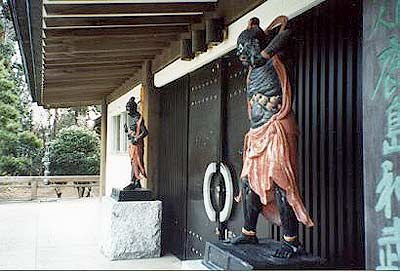 |
The door of the dojo at the Shimbuden. Photo by D. Klens-Bigman. |
But we did not have that much time to stay in our rooms anyway. After lunch, we changed our clothes (I augmented my training wear with a set of long underwear) and walked across the way (planted with plum trees, just beginning to come into reluctant bloom). After a brief opening ceremony, we set in to practice for the rest of the afternoon - Shindo Muso Ryu jodo, and some related kenjutsu (sword) techniques. I was somewhat gratified to realize that most of the crowd was older than college-age, and included some retirees. My worries about being able to survive an intensive training were somewhat laid to rest by the groans that arose from the floor during a fairly vigorous warm-up. All the same, three and a half days was a long time, and I tried to pace myself.
After a long afternoon of training, the dojo was locked up and we all retreated to get ready for dinner. More speeches of welcome in the warmth of the cafeteria, followed by announcements, including that there would be a gathering that evening in Kaminoda Sensei's room. Peter let me know it was for evening training in hojojutsu, learning to tie people up. Twenty or so grownups gathered in an overheated room, and began playing with balls of yarn. Among other things, Kaminoda Sensei trussed up a couple of senior students, pointing out some advantages to certain methods of tying, including that a prisoner's hands could be left free enough to allow him to eat, but not to do any harm, let alone escape. Though jetlag conspired with exhaustion and I was barely able to keep my eyes open, I had a great time learning to tie some knots.
By now I had several roommates, veterans of Kaminoda Sensei's gasshuku. Among other things, they had throat drops, candy and (best of all) chemical packets that generated heat for hours. Equipped with adhesive backs, the packs could be used anywhere. I found myself wishing that one crate of botan could have been exchanged for a crate of heat packs. I made a mental note that the next time someone mentioned the word "gasshuku" along with the word "winter" that I would definitely equip myself in a similar fashion.
By Sunday morning, I had resorted to two layers of long underwear and a wool sweater under my keikogi (I was beginning to look a little bit like the Michelin man of budo), and two pairs of tabi - cotton ones under the leather soled ones that Peter had wisely insisted I have with me. A sympathetic roommate had taken pity and parted with two heat packs, which I stuck to my thighs. Not only did it keep my legs warm, I could sneak my hands inside my hakama from time to time to warm them. And still, when we were not actively moving during practice, it was cold cold cold. Any moment when a patch of rare sunshine peeped through the windows of the dojo, people flocked to it during breaks, basking like animals in the relative warmth.
In fact, the dojo was quite pleasant in the afternoon when it was sunny, but by 4pm or so, what warmth there was crept away, and the very cold of early morning would return again. When it rained, it was sort of miserable all day long.
At this point, Peter managed to find a sympathetic menkyo-holder (licensed teacher) who did not mind taking a few nearly-clueless foreigners under his wing. Kato Sensei had both patience and a sense of humor. He made a great deal of my last name, "Bigman." Everyone who saw my name on the application thought it was actually my given name, written last as in Japanese style, and thought I was a strapping young man. They were quite surprised to find a round, middle-aged women with such an unlikely name. Kato Sensei kept noting it should really have been "big girl," since, though I am medium-sized (if not actually short) for an American, I was hardly that compared to Japanese women. However, being teased was a small price to pay for being led through the first level of koryu jodo, my first exposure to it. In some ways, Kato Sensei gave up his own valuable, high-level practice for our benefit. I was both humbled and grateful for the attention, even if it was embarrassing from time to time.
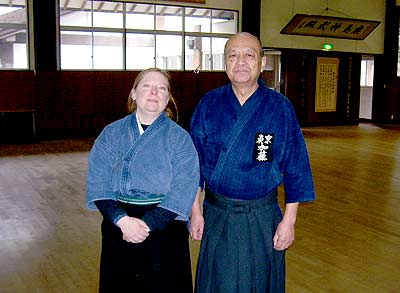 |
The author with Kato Sensei. Photo by Peter Boylan |
Sunday evening I reflected on what gasshuku really meant: there was nothing else but practice, food, practice, food, practice, food, sleep. I had not cleaned my contact lenses or done anything else personal beyond a daily bath for myself since my arrival Friday night (and the freezing cold, tiled floor in the ofuro insured these were as brief as possible). And it was just as well, for besides some time to write in my journal, there was little else to do: no television, no internet and (for me at least) no cell phone. I socialized a little, but the women who were staying beyond a day or two were often in bed asleep before I was, jet lag notwithstanding. And the people who did stay up late stayed up too late for me to keep up with.
By Monday morning I had further augmented my keikogi with a shitagi (a traditional garment worn under kimono). I was almost, at this point, warm enough, though I was helped by the fact that it was a modestly warm day
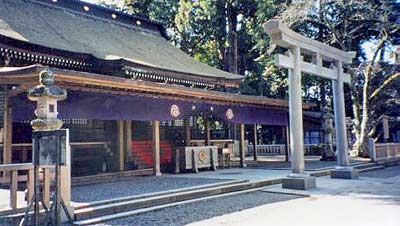 |
The main building at Kashima Jingu. Photo by D. Klens-Bigman. |
We started by heading off to Kashima Jingu for an enbu (martial arts demonstration) at the dojo building on the grounds. We began with a blessing by the priest of the shrine. (I could not help but notice the offering was several boxes of botan.) After that, we went to the dojo for the enbu.
 |
The dojo on the grounds of Kashima Jingu. Note the water tank in front, in case of fire. Photo by D. Klens-Bigman |
The shrine demo was exciting for multiple reasons, not least that we had no human audience per se. The humans had to view the proceedings from the sides or back of the space. The back doors of the dojo were opened to a square patch of ground marked off by shime (rice-straw rope) with paper strips attached to it, a designation of the space as being sacred to the gods - an area where they might come and observe. Kaminoda Sensei had all of us, in groups according to our ability, do jodo techniques and kata back and forth, as though we were showing the divine presence what progress (or lack thereof) we had made over the past several days.
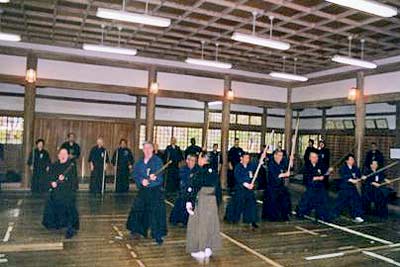 |
Showing jodo technique at the shrine. Kaminoda Sensei is in the foreground. Photo courtesy of T. Kaminoda. |
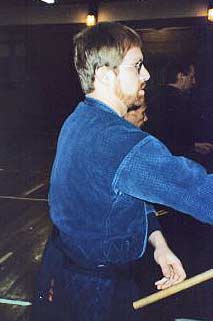 |
Peter Boylan at the shrine demo.
Photo by D. Klens-Bigman. |
Peter had told me there would be time for other arts to be performed, so I had brought my iaito (practice sword) with me. As soon as I heard Kaminoda Sensei announce it was time for the iai (sword-drawing) demo, I was ready, and staked out a corner for myself. The floor of the dojo was uneven, but worn smooth by thousands of bare feet over time. In my mind I dedicated my demo to Otani Sensei's memory and did my best not to screw it up. There were about a half-dozen other practitioners, each doing their own style and trying not to get into each other's way.
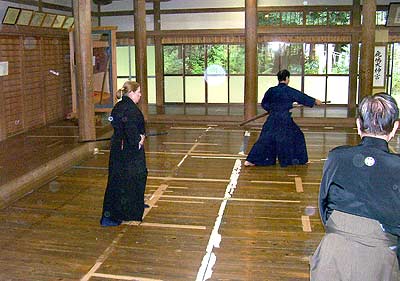 |
Performing iaido at the shrine demo.
Photo by Peter Boylan. |
Ordinarily the shrine enbu takes the entire morning, but because of the schedule that day it was rather brief. After about 1-1/2 hours, we piled back into cars and were off to Tsukahara Bokuden's grave to pay our respects.
Photo Kashima009 - Caption: Tsukahara Bokuden's grave during the prayer ceremony. Photo by D. Klens-Bigman
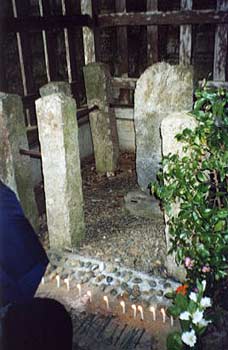 |
Tsukahara Bokuden's grave during the prayer ceremony. Photo by D. Klens-Bigman |
Bokuden (1490? - 1571) was a legendary swordsman and founder of the Kashima Shinto Ryu style of swordsmanship. There are many stories about him, and he was said to have taken part in many battles and won many duels (Friday 1997, 27n). He has become especially identified with Kashima Jingu, so no trip to the shrine is complete without paying respects at his grave.
After our return to the Shimbuden, we gathered in the dojo to receive certificates of our participation in both the enbu and the gasshuku. Some of us had more training ahead, and some were leaving. Part of the afternoon practice included a sort of enbu for ourselves. Beginners like myself were pushed to show the most advanced techniques we learned, or tried to learn, and the senior students showed their skill at kusarigama and other high-level techniques. Happily the menkyo-holder I was paired with pitied my enfeebled brain - between trying to absorb too much and an attack of nerves, I could do practically nothing. She led me through the kata and managed to get me to look somewhat decent doing them.
By Tuesday morning, only a small handful of us were left for one last session. As can sometimes happen at official gatherings, the last session was somewhat informal and slower paced. Everyone was tired, but it was the kind of feeling that came from knowing we pushed ourselves and did our best. The communal lunches that began with three long tables of participants had dwindled to one. Farewell speeches were made, and it was time to say goodbye. After seeing everyone else off at the bus stop for Tokyo, I retired to a hotel on the outskirts of town. It was pouring rain, but I was hoping to revisit Kashima Jingu to take photos the next day. The room was small and sort of stuffy, but the hotel had hot water, central heat, and a coin laundry! I felt a newly-profound appreciation for these simple things that most people take for granted every day.
About The Author:
Deborah Klens-Bigman is a well known teacher of Iaido in New York City. She has also
studied, to varying extents, kendo, jodo (short staff), kyudo (archery) and naginata (halberd). She received her Ph.D in 1995 from New York University's Department of Performance Studies where she wrote her dissertation on Japanese classical dance (Nihon Buyo). and she continues to study Nihon Buyo with Fujima Nishiki at the Ichifuji-kai Dance Association. Her article on the application of performance theory to Japanese martial arts appeared in the Journal of Asian Martial Arts in the summer of 1999. She is married to artist Vernon Bigman. For FightingArts.com she is Associate Editor for Japanese Culture/Sword Arts. |